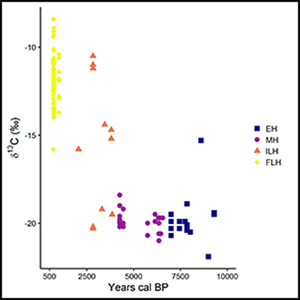Crossref Citations
This article has been cited by the following publications. This list is generated based on data provided by
Crossref.
Delgado, Miguel
2021.
Early Neotropical hunter-gatherers and the dynamics of the initial peopling of Northern South America.
Quaternary International,
Vol. 578,
Issue. ,
p.
1.
Nesbitt, Jason
Weber, Sadie L.
Washburn, Eden
Asencios, Bebel Ibarra
Titelbaum, Anne R.
Schroll, Andrew
and
Fehren-Schmitz, Lars
2023.
Diet During the Late Initial Period (1100–800 BC) in the Chavín Heartland: New Data from Canchas Uckro (North-Central Peru).
Journal of Ethnobiology,
Vol. 43,
Issue. 2,
p.
152.
Rivas, Sebastián
Calderón, Diana
Marulanda, Catherine
Mendoza, Luisa Fernanda
Scott, G. Richard
Poulson, Simon R.
and
Delgado, Miguel
2024.
Stable isotopes and paleodiet of the ancient inhabitants of Nueva Esperanza: A late Holocene site from Sabana de Bogotá (Colombia).
International Journal of Osteoarchaeology,
Vol. 34,
Issue. 3,
Vélez, Maria I
Salgado, Jorge
Delgado, Miguel
Patiño, Luisa F
Bird, Broxton
Escobar, Jaime H
and
Fajardo, Sebastian
2024.
Humans and climate in ritualized landscapes, the case of Lake Tota in the eastern highlands of Colombia.
The Holocene,
Vol. 34,
Issue. 11,
p.
1587.
Ziegler, Michael J.
Robinson, Mark
Aceituno, Francisco Javier
Morcote-Ríos, Gaspar
Becerra-Valdivia, Lorena
Carleton, William C.
Iriarte, José
and
Roberts, Patrick
2025.
Human dietary diversity in the Colombian Andes at the terminal Pleistocene-late Holocene sites Tequendama and Aguazuque.
iScience,
Vol. 28,
Issue. 1,
p.
111624.
Montalvo-Cabrera, Javier A.
Campbell, Roberto
Colonese, André C.
Palma, Gabriela
Lucquin, Alexandre
Talbot, Helen M.
Serna, Alejandro
Roa Solís, Constanza
Admiraal, Marjolein
and
Craig, Oliver E.
2025.
Evaluating the culinary significance of maize in the Araucanía, Southern Chile: Evidence from organic residue analysis of pre-colonial pottery.
Journal of Archaeological Science,
Vol. 173,
Issue. ,
p.
106118.
